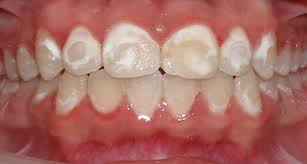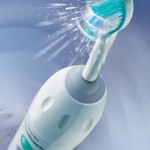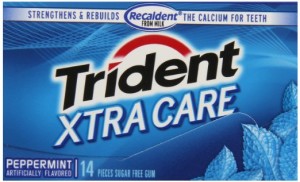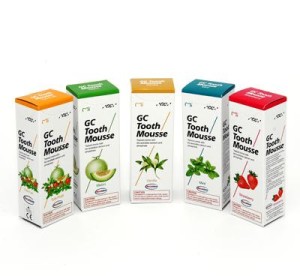White spots on teeth are generally not clearly visible and are normally a cosmetic concern, rather than something that will adversely affect the tooth’s health. However, white spots can appear very unsightly and affect a person’s confidence.

White Spots on Teeth
Causes of White Spots on Teeth
A very common cause is hypocalcification, which is the loss if minerals in the teeth. This often occurs in areas where the plaque accumulates and is not thoroughly removed. People often find white spots on their teeth after orthodontict treatment as plaque accumulates under the brackets where it is hard to fully clean. The plaque produces acids that attack the enamel and leaves white areas. In these cases I would generally not recommend teeth whitening as it will not remove the white areas and may even make it appear even worse. Please see the paragraph on how to get rid of white spots on teeth, to explore some of the options available.
Fluorosis occurs when children consume too much fluoride before their teeth are fully developed. White or even brown spots on the teeth due to fluorosis are fairly common in areas where there is too much fluoride in the drinking water. Teeth whitening may help in some cases, especially when there are brown areas on the teeth, although it often doesn’t give a satisfactory result.
Prevention of White Spots on Teeth
 Immaculate oral hygiene: Preferably use a good quality electric toothbrush such as Philips Sonicare and take care to clean the areas close to the gum line and around braces thoroughly. Floss daily and if you find it very hard due to braces, it may help to use a water flosser such as Waterpik. Mouth rinse is also very valuable as it can kill bacteria over an extended period and contains ingredients to strengthen the teeth.
Immaculate oral hygiene: Preferably use a good quality electric toothbrush such as Philips Sonicare and take care to clean the areas close to the gum line and around braces thoroughly. Floss daily and if you find it very hard due to braces, it may help to use a water flosser such as Waterpik. Mouth rinse is also very valuable as it can kill bacteria over an extended period and contains ingredients to strengthen the teeth.- Avoid fizzy drinks, especially those containing a lot of sugar.
- Clean your teeth after meals.
- Visit your dentist regularly, this means at least once every six months. Professional application of fluoride gel or varnish will help a lot to strengthen your teeth.
- Chew sugar free gum, preferably gum containing ACP. Chewing gum stimulates saliva flow which is your body’s own defense mechanism against attacks from bacteria producing acids and demineralizing enamel. The ACT helps to reminelalize the teeth.
- Use CCP-ACP containing paste.
- Avoiding fluorosis is very important in children whose permanent teeth are still developing. This can be done by ensuring that they do not drink water with too much fluoride and do not swallow fluoride-containing toothpaste or mouthwash. Do not give your child fluoride supplement tablets before consulting your dentist first.
How to get rid of White Spots on Teeth
- Improved oral hygiene
- Use GC Tooth Mousse (It may be more affective if the white spots are treated with an acid before you start using Tooth Mousse as it will help the Tooth Mousse to penetrate the enamel better.
-
Chew sugar-free gum containing ACP (Trident Xtra Care) , Recaldent (CPP-ACP) sugar-free gum with xylitol.
- Resin Infiltration: If there are still white spots after using products to remineralize your teeth, your dentist can apply a product like DMG ICON which is an infiltrating resing. It only takes one visit and the white spots may be gone or at least much less visible.
- Microabrasion: A mixture of pumice and hydrochloric acid is rubbed on the tooth surface until the white outer layers of the enamel is gently removed. This surface can then be treated with Tooth Mousse or if the defect is quite deep – composite resin.
- Composite filling material or Porcelain veneers. If the conservative treatments mentioned above is not sufficient. Especially in patients with severe fluorosis, composite bonding or the placement of porcelain veneers may give the most esthetic results.

Porcelain veneers
GC Tooth Mousse
I would like to say a bit more about this product as I honestly think it is great, not only to get rid of white spots on teeth but also for many other reasons. It contains calcium and phosphate, the major minerals in teeth. The minerals are carried in milk –derived protein called RECALDENT (APP-ACP), which makes it available in a soluble form to affectively remineralize teeth.
People who will greatly benefit from using GC Tooth Mousse
- Teeth Whitening: This is great to use before, between and after bleaching teeth. If the patient has fluorosis for instance, it will help to deal with the white areas. Tooth Mousse will also help to minimize sensitivity due to tooth bleaching.
- White areas due to hypomineralisation and cases of enamel Hypoplasia: Impaired enamel formation results in the accumulation of water in voids within the enamel. This causes opacity. It will be helpful if your dentist can use microabrasion or acid etching on the outer surface of the enamel first. The GC Tooth Mousse should then be applied to the affected areas, preferably with the finger and before bed time. Do not expect results immediately as it usually takes about 6 weeks to get a good result.
- Orthodontics: GC Tooth Mouse should be used during orthodontic treatment to prevent demineralization of the teeth. After treatment orthodontic treatment RecaldentTM CPP-ACP has been shown to have a dramatic effect on white spots.
- Mild fluorosis – Etching or microabrasion, followed by Tooth Mousse can achieve great results after several weeks.
- Special needs patients and the elderly often find it difficult to maintain good oral hygiene. Using Tooth Mousse will greatly reduce the demineralizasion and eventual decay caused by plaque left on teeth.
- Tooth Erosion: Tooth erosion is typically due to acids damaging teeth due to regular consumption of fizzy or other acidic drinks. Tooth Mousse will help to limit the damage and restore areas with demineralization.
- Dry mouth (Xerostomia): Saliva naturally helps to protect your teeth. People with xerostomia often gets more tooth decay than others and Tooth Mousse is ideal to help and protect their teeth.
Know that you know how to get rid of white spots on teeth, please leave a comment if you tried any of the treatments mentioned. I am sure other readers will find it helpful.





